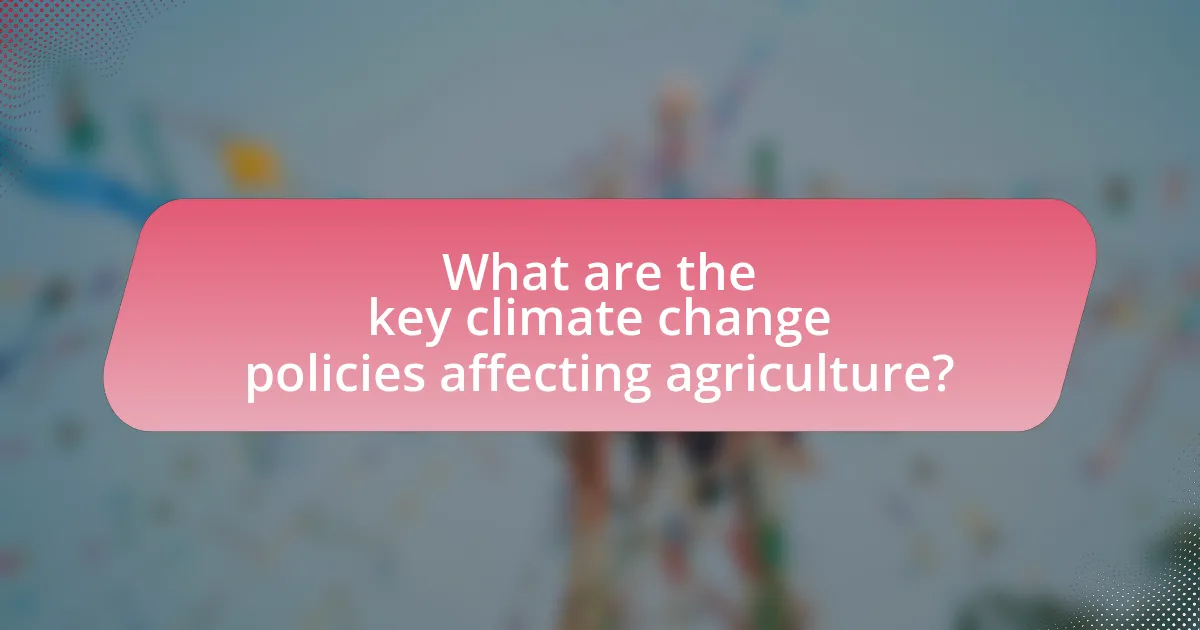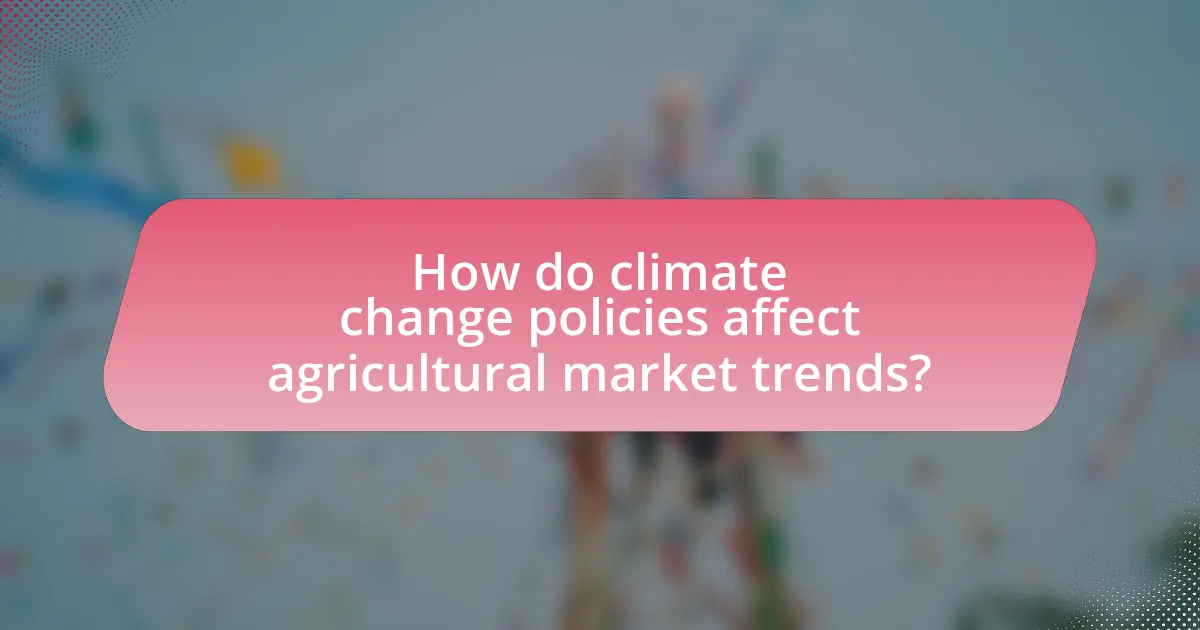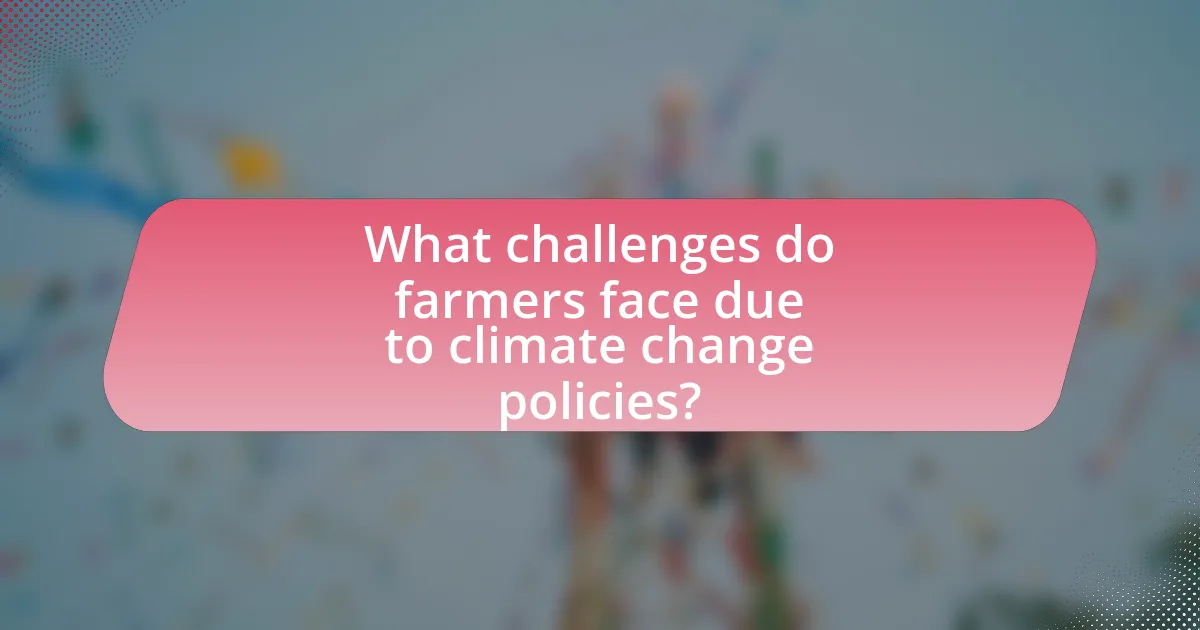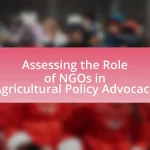The article examines the impact of climate change policies on agricultural market trends, highlighting key regulations such as carbon pricing, emissions reduction targets, and sustainable land management practices. It discusses how these policies influence agricultural practices by promoting sustainability and incentivizing the adoption of eco-friendly techniques. The article also explores the implications of international agreements, such as the Paris Accord, on national agricultural strategies and market dynamics, including shifts in consumer preferences towards organic and sustainable products. Additionally, it addresses the challenges farmers face in adapting to these policies, the financial burdens involved, and the potential benefits of embracing sustainable practices for long-term resilience and market competitiveness.

What are the key climate change policies affecting agriculture?
Key climate change policies affecting agriculture include carbon pricing, emissions reduction targets, and sustainable land management practices. Carbon pricing incentivizes farmers to reduce greenhouse gas emissions by assigning a cost to carbon emissions, which can lead to more sustainable farming practices. Emissions reduction targets set by governments aim to lower overall agricultural emissions, encouraging the adoption of technologies and practices that enhance efficiency and reduce waste. Sustainable land management practices, promoted through various policies, focus on soil health, water conservation, and biodiversity, which are essential for resilient agricultural systems. These policies collectively influence agricultural market trends by shifting production methods and consumer preferences towards more sustainable options.
How do these policies influence agricultural practices?
Climate change policies significantly influence agricultural practices by promoting sustainable farming techniques and incentivizing the reduction of greenhouse gas emissions. These policies often include regulations that encourage the adoption of practices such as crop rotation, reduced tillage, and organic farming, which enhance soil health and biodiversity. For instance, the European Union’s Common Agricultural Policy provides financial support for farmers who implement environmentally friendly practices, leading to a measurable increase in sustainable agriculture across member states. Additionally, policies that impose carbon pricing create economic incentives for farmers to adopt practices that lower their carbon footprint, thereby reshaping agricultural production methods to align with climate goals.
What specific regulations are implemented to mitigate climate change in agriculture?
Specific regulations implemented to mitigate climate change in agriculture include the European Union’s Common Agricultural Policy (CAP), which promotes sustainable farming practices and incentivizes farmers to reduce greenhouse gas emissions. Additionally, the United States has regulations under the Environmental Protection Agency (EPA) that enforce limits on emissions from agricultural operations, such as methane from livestock. These regulations are supported by scientific studies indicating that sustainable practices can significantly lower carbon footprints; for instance, a report by the Food and Agriculture Organization (FAO) highlights that adopting agroecological practices can reduce emissions by up to 30%.
How do these regulations impact crop production and farming methods?
Regulations related to climate change significantly impact crop production and farming methods by mandating sustainable practices and reducing greenhouse gas emissions. These regulations often require farmers to adopt precision agriculture techniques, which optimize resource use and minimize environmental impact, thereby enhancing crop yields. For instance, the implementation of the European Union’s Common Agricultural Policy encourages practices such as crop rotation and organic farming, which have been shown to improve soil health and biodiversity, leading to more resilient agricultural systems. Additionally, regulations may incentivize the use of renewable energy sources on farms, further reducing reliance on fossil fuels and contributing to lower operational costs in the long term.
What role do international agreements play in shaping agricultural policies?
International agreements play a crucial role in shaping agricultural policies by establishing frameworks for cooperation, setting standards, and promoting sustainable practices among nations. These agreements, such as the Paris Agreement, influence national policies by encouraging countries to adopt measures that mitigate climate change impacts on agriculture, thereby aligning agricultural practices with global sustainability goals. For instance, the Food and Agriculture Organization (FAO) emphasizes that international commitments can lead to the adoption of climate-smart agricultural practices, which enhance resilience and productivity. Additionally, trade agreements often include provisions that affect agricultural subsidies and market access, directly impacting domestic agricultural policies and practices.
How do agreements like the Paris Accord affect national agricultural strategies?
Agreements like the Paris Accord significantly influence national agricultural strategies by mandating reductions in greenhouse gas emissions, which compel countries to adopt more sustainable farming practices. For instance, nations are encouraged to implement climate-smart agriculture techniques that enhance resilience to climate change while reducing carbon footprints. The Paris Accord’s goal of limiting global warming to well below 2 degrees Celsius drives governments to invest in research and development of sustainable agricultural technologies, such as precision farming and agroforestry. Additionally, countries may face economic incentives or penalties based on their adherence to these agreements, further motivating shifts in agricultural policies towards sustainability.
What are the implications of these agreements for global agricultural markets?
The implications of these agreements for global agricultural markets include shifts in trade patterns, price volatility, and changes in production practices. These agreements often promote sustainable practices that can lead to increased costs for farmers, which may be passed on to consumers, thereby affecting market prices. For instance, the Paris Agreement encourages countries to reduce greenhouse gas emissions, which can lead to stricter regulations on agricultural practices. As a result, countries that adapt quickly may gain a competitive advantage in the market, while those that lag may face economic challenges. Historical data shows that countries implementing climate policies have seen fluctuations in agricultural exports, impacting global supply chains and food security.

How do climate change policies affect agricultural market trends?
Climate change policies significantly influence agricultural market trends by altering production practices, input costs, and market access. For instance, policies promoting sustainable farming practices can lead to increased costs for farmers due to the need for new technologies and compliance measures. According to a report by the Food and Agriculture Organization, the implementation of carbon pricing can raise production costs by 10-20%, affecting market prices and competitiveness. Additionally, climate policies can shift demand towards more sustainable products, impacting market trends as consumers increasingly favor environmentally friendly options. This shift is evidenced by a 2021 study from the International Food Policy Research Institute, which found that demand for organic produce has risen by 30% in regions with stringent climate policies. Thus, climate change policies reshape agricultural markets by influencing both supply-side costs and consumer demand dynamics.
What are the direct impacts of these policies on market prices?
Climate change policies directly impact market prices by increasing production costs and altering supply dynamics. For instance, regulations aimed at reducing greenhouse gas emissions often require farmers to invest in new technologies or practices, which can raise operational expenses. According to a study by the Food and Agriculture Organization, the implementation of carbon pricing can lead to a 10-20% increase in the cost of agricultural production, subsequently driving up market prices for food products. Additionally, policies that promote sustainable practices may limit the availability of certain crops, further constraining supply and elevating prices.
How do subsidies and incentives alter market dynamics?
Subsidies and incentives significantly alter market dynamics by influencing supply and demand within agricultural sectors. When governments provide financial support to farmers, it lowers production costs, encouraging increased output and potentially leading to lower prices for consumers. For instance, the U.S. government’s subsidies for corn production have historically resulted in an oversupply, which can depress market prices and affect crop diversity. Additionally, incentives for sustainable practices can shift market dynamics by promoting environmentally friendly products, thereby increasing demand for organic and sustainably sourced goods. This shift is evidenced by the growing market for organic produce, which has expanded by over 50% in the last decade, driven by consumer preference and supportive policies.
What trends are emerging in commodity prices due to climate policies?
Emerging trends in commodity prices due to climate policies include increased volatility and upward pressure on prices for agricultural commodities. Climate policies, such as carbon pricing and emissions reduction targets, are driving a shift towards sustainable farming practices, which often require higher initial investments and can lead to reduced supply in the short term. For instance, the implementation of stricter regulations on fertilizers and pesticides has resulted in increased production costs, contributing to higher prices for crops like corn and soybeans. Additionally, the transition to renewable energy sources is affecting the prices of commodities like oil and natural gas, as demand for fossil fuels decreases and alternative energy sources become more prevalent. This shift is evidenced by the International Energy Agency’s report indicating that global investment in renewable energy reached $300 billion in 2020, influencing market dynamics across various commodities.
How do consumer preferences shift in response to climate policies?
Consumer preferences shift towards more sustainable and eco-friendly products in response to climate policies. This shift is driven by increased awareness of environmental issues and the influence of regulations that promote sustainable practices. For instance, studies show that consumers are more likely to purchase organic and locally sourced food when governments implement policies that support sustainable agriculture, such as subsidies for organic farming or taxes on carbon emissions. According to a 2021 survey by the Food Marketing Institute, 70% of consumers indicated they would change their purchasing habits to reduce their environmental impact, demonstrating a clear link between climate policies and consumer behavior.
What role does sustainability play in consumer purchasing decisions?
Sustainability significantly influences consumer purchasing decisions by driving preferences towards eco-friendly products. Research indicates that 66% of global consumers are willing to pay more for sustainable brands, reflecting a growing demand for environmentally responsible options. This trend is particularly evident among younger demographics, with 73% of millennials stating they would change their consumption habits to reduce environmental impact. Such statistics underscore the importance of sustainability in shaping market trends, as businesses increasingly align their offerings with consumer values to remain competitive.
How are organic and eco-friendly products affected by climate change policies?
Organic and eco-friendly products are positively influenced by climate change policies that promote sustainable agricultural practices. These policies often include incentives for reducing carbon emissions, which align with the principles of organic farming that emphasize soil health and biodiversity. For instance, the European Union’s Green Deal aims to make agriculture more sustainable, thereby increasing demand for organic products as consumers seek environmentally responsible options. Additionally, research from the Food and Agriculture Organization indicates that organic farming can enhance resilience to climate change, further supporting the growth of this market segment.

What challenges do farmers face due to climate change policies?
Farmers face significant challenges due to climate change policies, primarily including increased regulatory compliance costs and market volatility. These policies often require farmers to adopt sustainable practices, which can necessitate substantial investments in new technologies and equipment. For instance, a study by the USDA found that transitioning to more sustainable farming methods can increase operational costs by up to 30%. Additionally, climate change policies can lead to fluctuating market prices for crops, as government incentives and penalties shift supply and demand dynamics. This volatility can make it difficult for farmers to plan financially, impacting their long-term viability.
How do compliance costs impact small versus large-scale farmers?
Compliance costs disproportionately burden small-scale farmers compared to large-scale farmers. Small-scale farmers often operate with tighter profit margins and fewer resources, making it challenging to absorb the costs associated with compliance to regulations, such as environmental standards or safety protocols. For instance, a study by the USDA found that small farms spend a higher percentage of their revenue on compliance costs than larger farms, which can allocate resources more efficiently due to economies of scale. Consequently, small-scale farmers may face financial strain, leading to reduced competitiveness and potential market exit, while large-scale farmers can more easily manage these costs, maintaining their market position.
What financial burdens do farmers encounter when adapting to new regulations?
Farmers encounter significant financial burdens when adapting to new regulations, primarily due to increased costs associated with compliance, investment in new technologies, and potential loss of productivity during the transition period. Compliance costs can include expenses for training, documentation, and modifications to existing practices to meet regulatory standards. For instance, a study by the USDA found that farmers may spend up to 20% of their operating budget on compliance-related activities when new environmental regulations are implemented. Additionally, investments in advanced technologies, such as precision agriculture tools, can require substantial upfront capital, which may not yield immediate returns. Furthermore, during the adaptation phase, farmers may experience reduced yields or operational disruptions, leading to decreased income. These financial challenges can strain farmers’ cash flow and overall economic viability, particularly for small and medium-sized operations.
How do these costs influence market competition among farmers?
Costs associated with climate change policies significantly influence market competition among farmers by affecting their operational expenses and pricing strategies. Higher costs for compliance with environmental regulations, such as implementing sustainable practices or investing in renewable energy, can reduce profit margins for farmers. Consequently, farmers with lower operational costs may gain a competitive advantage, allowing them to offer lower prices or invest more in marketing and technology. For instance, a study by the Food and Agriculture Organization (FAO) indicates that farmers who adopt eco-friendly practices may face initial financial burdens but can achieve long-term savings and market differentiation. This dynamic creates a competitive landscape where only those who can efficiently manage these costs thrive, while others may struggle to remain viable.
What are the potential benefits of adapting to climate change policies?
Adapting to climate change policies can enhance agricultural resilience and productivity. By implementing these policies, farmers can access improved technologies and practices that mitigate the impacts of climate variability, leading to increased crop yields. For instance, a study by the Food and Agriculture Organization (FAO) indicates that climate-smart agriculture can boost productivity by up to 20% while reducing greenhouse gas emissions. Additionally, adapting to these policies can improve water management and soil health, further supporting sustainable agricultural practices. This adaptation not only secures food supply but also stabilizes market trends by reducing the volatility associated with climate-related disruptions.
How can innovation in agricultural practices lead to market advantages?
Innovation in agricultural practices can lead to market advantages by enhancing productivity, reducing costs, and improving product quality. For instance, the adoption of precision agriculture technologies allows farmers to optimize resource use, resulting in higher yields and lower input costs. According to a study by the Food and Agriculture Organization, precision agriculture can increase crop yields by 10-20% while reducing fertilizer use by 15-30%. Additionally, innovative practices such as crop rotation and integrated pest management can improve soil health and reduce dependency on chemical inputs, leading to sustainable farming that appeals to environmentally conscious consumers. This shift not only meets market demand for sustainable products but also positions farmers competitively in a market increasingly influenced by climate change policies.
What opportunities arise from sustainable farming initiatives?
Sustainable farming initiatives create opportunities for increased market access, improved crop resilience, and enhanced ecosystem services. These initiatives often lead to the adoption of practices that reduce environmental impact, such as organic farming and agroecology, which can attract consumers seeking environmentally friendly products. For instance, the global organic food market was valued at approximately $120 billion in 2020 and is projected to grow significantly, indicating a rising demand for sustainably produced goods. Additionally, sustainable practices can enhance soil health and biodiversity, leading to better yields and reduced vulnerability to climate change, thereby ensuring food security.
What strategies can farmers employ to navigate these changes effectively?
Farmers can employ diversification of crops and practices to navigate changes effectively. By adopting a variety of crops, farmers can reduce risk associated with climate variability and market fluctuations. For instance, research indicates that diversified farming systems can enhance resilience to climate change impacts, as they allow for better adaptation to changing weather patterns and market demands. Additionally, implementing sustainable practices such as precision agriculture and agroecology can improve resource efficiency and reduce environmental impact, aligning with climate change policies. Studies show that these strategies not only support environmental sustainability but also enhance economic viability, providing farmers with a competitive edge in evolving agricultural markets.
How can farmers leverage technology to comply with climate policies?
Farmers can leverage technology to comply with climate policies by adopting precision agriculture tools that optimize resource use and reduce emissions. These technologies include GPS-guided equipment, soil sensors, and data analytics platforms that enable farmers to monitor crop health, manage irrigation efficiently, and apply fertilizers more accurately. For instance, a study by the USDA found that precision agriculture can reduce nitrogen fertilizer use by up to 20%, which directly aligns with climate policies aimed at lowering greenhouse gas emissions. Additionally, the integration of renewable energy sources, such as solar panels for powering farm operations, further supports compliance with climate regulations by decreasing reliance on fossil fuels.
What best practices can enhance resilience in agricultural markets?
Best practices that can enhance resilience in agricultural markets include diversifying crops, implementing sustainable farming practices, and utilizing technology for data-driven decision-making. Diversifying crops reduces dependency on a single commodity, thereby mitigating risks associated with market fluctuations and climate impacts. Sustainable farming practices, such as crop rotation and organic farming, improve soil health and increase productivity over time, which can buffer against adverse weather conditions. Additionally, technology, such as precision agriculture and climate forecasting tools, enables farmers to make informed decisions, optimize resource use, and adapt to changing environmental conditions. These strategies collectively strengthen the agricultural sector’s ability to withstand shocks and maintain stability in the face of climate change.















